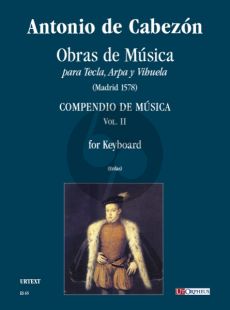Antonio de Cabezón (or Cabeçon) was born on 30 March 1510 at Castrillo de Matajudíos to Sebastián de Cabezón and María Gutiérrez, small-scale landowners. Little is known about his childhood, apart from the fact that he went blind at an early age. After starting to study music he moved to Palencia, the seat of Spain's most ancient university, where he found a protector in Esteban Martínez de Cabezón, canon in the Cathedral of Burgos, vicar general of the diocese of Palencia and apostolic inquisitor. He appears to have studied with Garcia Baeza, organist of the Cathedral of Palencia; in August 1522 he had his first encounter with the Spanish royal family. In 1525 Cabezón moved to Toledo and the following year, when still only 16, he was appointed organist to Queen Isabella and began to play a part in the musical life of the Capilla Musical of her consort, Charles V. In 1538 he married Luisa Núnez; of their five children, one of the three sons, Hernando, also became a court musician. On the death of Queen Isabella, Antonio passed into the service of the royal children Felipe (the future Felipe II, the Prudent), María and Juana. From 1548 onwards he entered the personal service of Felipe, establishing himself as a particular favourite, along with the painter Titian. He accompanied the heir to the throne on numerous journeys: lengthy stays in the Low Countries, England, Italy and Germany were decisive for Cabezón's musical output, giving him firsthand experience of other musical idioms. At the same time there can be no doubt that his music served as a model and inspiration for the foreign musicians with whom he came into contact.Cabezón died in Madrid on 26 May 1566. Twelve years after his death his son Hernando published in Madrid the volume Obras de Música para Tecla, Arpa y Vihuela, a collection of many of his father's compositions with the addition of some pieces by himself and his uncle Juan. Cabezón's output is of considerable importance in the panorama of Western music, for it was Spain, rather than Italy, that first saw the emergence of an original repertory for keyboard, and Cabezón was the leading exponent in this genre. He oversaw the emancipation of the keyboard from merely serving to reproduce the vocal parts, enabling it to develop an idiomatic language of its own. Keyboard instruments undoubtedly played a significant role in the Spain of the Reconquista under Isabel la Católica (grandmother of Charles V). The court inventory drawn up in 1503, a year before her death, lists numerous such instruments including dos clavicímbanos viejos. We know from contemporary accounts that Isabel herself was a keen harpsichordist, although unfortunately no record has survived of the repertory she preferred.Music played an important role in court life, with pride of place going to polyphony, all the more so on the accession of Charles V, who brought with him many artists from his homeland in the Low Countries. These musicians were organized into the Capilla Flamenca, which took its place alongside the Capilla Musical, made up of musicians from Spain, Portugal and Italy.Thus on entering the service of the royal family Antonio would have come into contact with the leading Flemish musicians employed in the Capilla Flamenca, including Nicolas Gombert (its director), Thomas Crecquillon, Jean Mouton and Clemens non Papa, and his compositions drew on their motets and chansons.From 1538 to 1561 Cabezón lived in the city of Alcalà de Henares, where in 1557 the volume Libro de Cifra Nueva para Tecla, Arpa y Vihuela was published by Luis Venegas de Henestrosa, a prelate and musician in the service of the Cardinal of Toledo.











